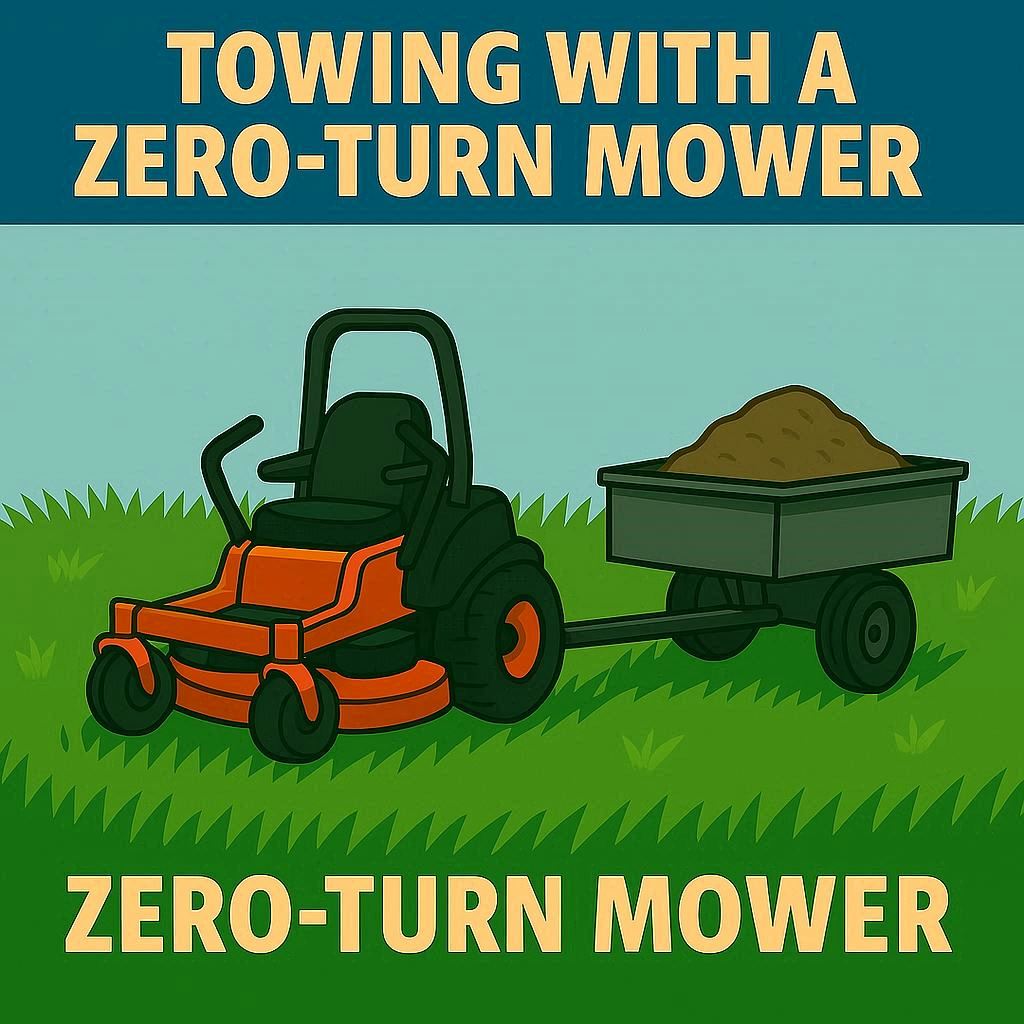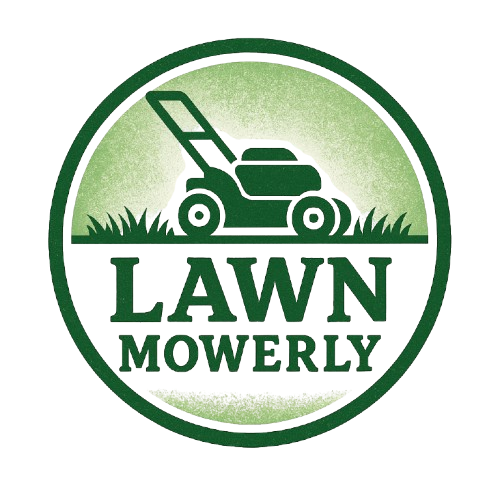
Zero-turn mowers are known for their speed, agility, and precision when cutting grass. But when you own large property, it’s tempting to wonder: can you tow with a zero-turn mower?
The short answer is yes, you can—but with caution, the right equipment, and an understanding of your mower’s design limits. Improper towing can lead to mechanical damage, voided warranties, and even safety hazards.
This guide breaks down everything you need to know about towing with a zero-turn mower—including towing capacities, best practices, potential risks, and recommended attachments.
🔧 Understanding Zero-Turn Mowers
Before we get into towing, it’s essential to understand how a zero-turn mower (ZTR) is built.
1. Drive System
Zero-turns rely on hydrostatic transmissions that use hydraulic fluid to power each rear wheel independently. This gives the mower its signature maneuverability — but it also means the system isn’t designed for high torque loads.
Towing adds resistance and strain to the hydrostatic system, potentially leading to:
- Overheating of the hydraulic fluid
- Premature wear or seal leaks
- Reduced transmission life
2. Frame & Weight Distribution
ZTRs are designed for mowing efficiency, not hauling. Their frames are optimized for balanced weight over the drive tires, allowing precise turns. Adding weight behind the rear wheels (like a trailer or cart) shifts the balance and can cause instability or loss of steering control — especially on slopes.
3. Braking
Zero-turn mowers don’t have traditional braking systems. When you release the handles, the hydraulic pumps slow the wheels — but they’re not designed to stop extra towed weight. This becomes a real hazard on inclines or rough terrain.
⚖️ Can You Tow With a Zero-Turn Mower?
Yes — but only within the manufacturer’s rated towing capacity and with proper attachments. Most zero-turn mowers can safely tow between 180 to 400 pounds, depending on model and build quality.
Heavy-duty or commercial zero-turns can often handle more (up to 600–700 pounds), while entry-level residential models should stay below 250 pounds total load.
Always check your owner’s manual for the exact towing limit — exceeding it can void your warranty or damage components.
📏 Typical Towing Capacities by Brand (Approximate Ranges)
| Brand / Series | Example Model | Approx. Towing Capacity* | Notes |
|---|---|---|---|
| John Deere ZTrak | Z335E / Z530M | 250–400 lbs | Strong frame, optional hitch kits available |
| Toro TimeCutter / Titan | TimeCutter 75760 | 300–500 lbs | Toro offers specific hitch attachments |
| Husqvarna Z200/Z400 | Z254F / Z460 | 250–350 lbs | Residential frames; stay light |
| Cub Cadet Ultima ZT1/ZTX | ZT1 60 / ZTX4 | 250–400 lbs | Reinforced models tow better |
| Ariens / Gravely | Ikon XD / ZT HD | 250–500 lbs | Heavy-duty welded frames handle modest towing |
| Bad Boy Mowers | Maverick / Rogue | 400–700 lbs | Commercial-grade build, can handle moderate loads |
| Ferris ISX Series | ISX 800 / 2200 | 400–600 lbs | Commercial suspension helps stability |
*Always verify specific model ratings from manufacturer documentation.
🚜 What You Can Safely Tow with a Zero-Turn
Here are examples of accessories and tools within a safe towing range for most ZTRs:
- Small garden carts or dump trailers (loaded under weight limit)
- Spreaders for fertilizer or seed
- Lawn rollers (use half-filled with water, not full)
- Plug aerators
- Small dethatchers
- Light utility trailers (empty or with lightweight tools)
Avoid towing:
- Logs, large debris, or heavy landscaping materials
- Fully loaded steel trailers
- Trailers on steep grades
- Boats, ATVs, or large loads exceeding limits
⚙️ How to Set Up Your Zero-Turn for Safe Towing
1. Install a Proper Hitch Kit
Most zero-turns don’t come with a hitch from the factory. You’ll need a manufacturer-approved hitch kit designed for your model.
Universal hitch plates exist, but custom-fit kits ensure correct height and weight alignment.
Types of hitches:
- Bolt-on plate hitches: Attach to the frame or rear guard bar.
- Receiver hitches (2” style): Found on some commercial models; compatible with trailers and yard tools.
- Pin hitches: Simple and lightweight, suitable for garden carts or spreaders.
⚠️ Avoid DIY welding or drilling the frame. It may compromise mower integrity or void warranty coverage.
2. Distribute Weight Correctly
Keep most of the towed weight over the trailer’s axle — not at the tongue. A tongue weight around 10–15% of total load is ideal. Too much tongue weight can lift the mower’s front wheels and affect steering.
Example:
If your load weighs 300 lbs, tongue weight should be about 30–45 lbs.
3. Mow and Tow on Level Ground
Use your zero-turn for towing only on flat, stable surfaces. Avoid:
- Slopes above 10 degrees
- Wet or muddy terrain
- Gravel driveways (causes wheel spin and poor braking)
Remember — zero-turns have powerful drives but limited traction and braking on inclines.
4. Keep Speeds Low
Maximum safe towing speed is 3–5 mph on flat ground. Higher speeds risk fishtailing, jackknifing, or damage to the hydrostatic transmission.
5. Avoid Sharp Turns
Zero-turns can pivot 180°—but never attempt a zero-radius turn while towing. The trailer or cart can jackknife, damaging both mower and load.
Instead, make wide, gentle turns and release both levers slowly when changing direction.
💡 Tips to Prevent Damage While Towing
- Check tire pressure: Proper inflation ensures traction and stability.
- Use low throttle when starting: Prevents sudden torque shock to hydraulics.
- Inspect hitch hardware: Tighten bolts and pins before every use.
- Monitor hydrostatic fluid: More towing equals more heat — check levels regularly.
- Let mower cool down: After heavy towing, idle the engine for 1–2 minutes before shutdown.
⚠️ Dangers of Over-Towing
Ignoring weight ratings or using a zero-turn as a utility tractor can lead to:
- Hydraulic system failure: Heat buildup damages seals and pumps.
- Frame bending or cracking: Especially with heavy tongue weights.
- Tire blowouts or rutting: Turf tires aren’t designed for constant pulling.
- Steering loss or tip-over: Particularly downhill or uneven ground.
- Voided warranty: Most mower warranties exclude towing-related damage.
Always remember — zero-turns are mowing machines first, and only light-duty haulers second.
🧰 Alternatives for Heavier Hauling
If you frequently need to tow over 500–700 lbs, consider using:
- Garden or lawn tractors: Built with gear-drive transmissions for pulling.
- Compact utility tractors (CUTs): For large acreage and heavy implements.
- ATVs or UTVs: Designed to handle trailer loads safely on mixed terrain.
A dedicated towing machine prevents premature mower wear and saves you money long term.
✅ Pros and Cons of Towing With a Zero-Turn
| Pros | Cons |
|---|---|
| Convenient for light yard work | Limited towing capacity |
| Saves time for small hauling jobs | Can damage hydrostatic drive |
| Easy to attach lightweight carts | Poor traction on slopes |
| Makes multi-tasking possible (spreading, rolling) | Risk of jackknifing during sharp turns |
| Versatile for small property maintenance | May void warranty if overloaded |
🔩 Recommended Towing Accessories for Zero-Turns
| Accessory | Function | Best Use |
|---|---|---|
| Hitch Plate Kit | Mounting point for towing | Compatible with most ZTRs |
| Lawn Cart (Poly or Steel) | Transport tools, soil, mulch | Up to 300 lbs load |
| Tow-Behind Spreader | Fertilizer or seed distribution | Smooth lawns only |
| Plug Aerator | Lawn aeration and dethatching | Use half-weight load |
| Lawn Roller | Flatten uneven areas | Use partially filled |
Brands like Agri-Fab, Brinly, and Ohio Steel make mower-compatible carts and aerators designed with low tongue weight.
🧭 Real-World Tips from Professionals
- Plan towing tasks separately from mowing. Mow first, tow later — it’s safer and puts less strain on the mower.
- Use counterweights carefully. Adding small front weights can help balance tongue load, but check manual before modification.
- Avoid towing on slopes. Downhill towing is a major cause of zero-turn instability.
- Keep towing time short. Don’t pull for more than 15–20 minutes continuously.
- Listen to your machine. Whining or slipping noises from the hydraulics mean it’s time to stop and cool down.
🧠 FAQ: Towing With Zero-Turn Mowers
1. Can I use my zero-turn to pull a trailer?
Yes, if the trailer and load are within your mower’s rated towing capacity — typically 250–400 lbs for residential ZTRs.
2. Will towing void my mower warranty?
Not always, but damage caused by overloading or improper towing (e.g., hitching directly to frame holes) may not be covered.
3. Can I use a hitch ball for towing?
Only if your mower’s hitch supports it. Some zero-turns use simple pin hitches that don’t accept standard trailer couplers.
4. Can I tow uphill?
Avoid steep inclines. Zero-turns lack traction and braking power for safe towing uphill or downhill.
5. What’s better for towing — zero-turn or lawn tractor?
A lawn or garden tractor is better for consistent towing. Zero-turns are optimized for mowing, not pulling.
6. Can I tow with an electric zero-turn mower?
Some electric models (like EGO or Ryobi) allow light towing — always confirm with manufacturer guidelines to prevent motor overload.
7. What happens if I tow too much weight?
You risk hydraulic pump failure, drive damage, and voiding your warranty. The cost of repair usually exceeds any benefit from towing heavy loads.
Here’s a summary + commentary of the “Zero-turn towing capacity for famous brands” information from the Desired Lawn Mower article, along with cautions and insights:
Towing Capacities from Desired Lawn Mower
The article lists estimated towing capacities for various brands and models of zero-turn mowers. It uses a rule of thumb: avoid towing more than 50 % (or up to 60 %) of the mower’s total weight capacity — and subtract the operator’s weight.
Here are some examples they cite:
| Brand / Model | Mower Weight (claimed) | Estimated Towing Capacity |
|---|---|---|
| Cub Cadet | ZT1-42: 500 lbs | 250 – 300 lbs |
| ZT2-60: 752 lbs | 376 – 451 lbs | |
| ZTX4-60: 1,092 lbs | 546 – 655 lbs | |
| John Deere | Z335E: 491 lbs | 245 – 294 lbs |
| Z530M: 780 lbs | 390 – 468 lbs | |
| Z930M: 1,275 lbs | 637 – 765 lbs | |
| Husqvarna | Z142: 474 lbs | 237 – 284 lbs |
| Z460: 823 lbs | 411 – 493 lbs | |
| Z560X: 1,309 lbs | 654 – 785 lbs | |
| Bad Boy | Maverick: 1,005 lbs | 502 – 603 lbs |
| Rogue: 1,538 lbs | 769 – 922 lbs | |
| Toro | TimeCutter 75734: 675 lbs | 337 – 405 lbs |
| Titan 75316: 819 lbs | 409 – 491 lbs | |
| Kubota | Z231KW-42: 621 lbs | 310 – 372 lbs |
| Z725KH-60: 1,256 lbs | 628 – 753 lbs | |
| Ariens | Zenith 60 Kawasaki: 900 lbs | 450 – 540 lbs |
| Ikon-XD 60: 697 lbs | 348 – 418 lbs | |
| Troy-Bilt | Mustang Z42: 580 lbs | 290 – 348 lbs |
These towing capacities are “excludes rider’s weight”—meaning you must deduct your own weight to find how much additional load you can tow.
🛑 Caveats & Critical Notes
- These are rule-of-thumb estimates based on a percentage of mower “weight capacity” — not necessarily the actual structural or drivetrain limits of each model.
- Manufacturer specifications vary and many zero-turns don’t officially rate a towing capacity. The listed numbers should be verified against manufacturer manuals or dealer specs.
- Using more than a small fraction of the mower’s designed pulling capacity can overstress transmissions, frames, or hydraulics.
- Always subtract the operator’s weight (and any cargo on the mower itself) from the “estimated towing capacity.”
🚀 Final Thoughts
You can tow with a zero-turn mower — but treat it as a light-duty helper, not a replacement for a tractor or ATV.
Stay within rated towing limits, use proper hitching equipment, and avoid slopes or overloading. When done right, your zero-turn can safely pull a cart, spreader, or aerator — extending its usefulness around your property without shortening its lifespan.

I’m David man behind Lawn Mowerly; I’ve been dealing with lawnmowers and Tractors with my father since I was a kid. I know every make and model and what each one is capable of and love helping people find the perfect equipment for their needs.
